2005 CHEVROLET EQUINOX seat adjustment
[x] Cancel search: seat adjustmentPage 7 of 364
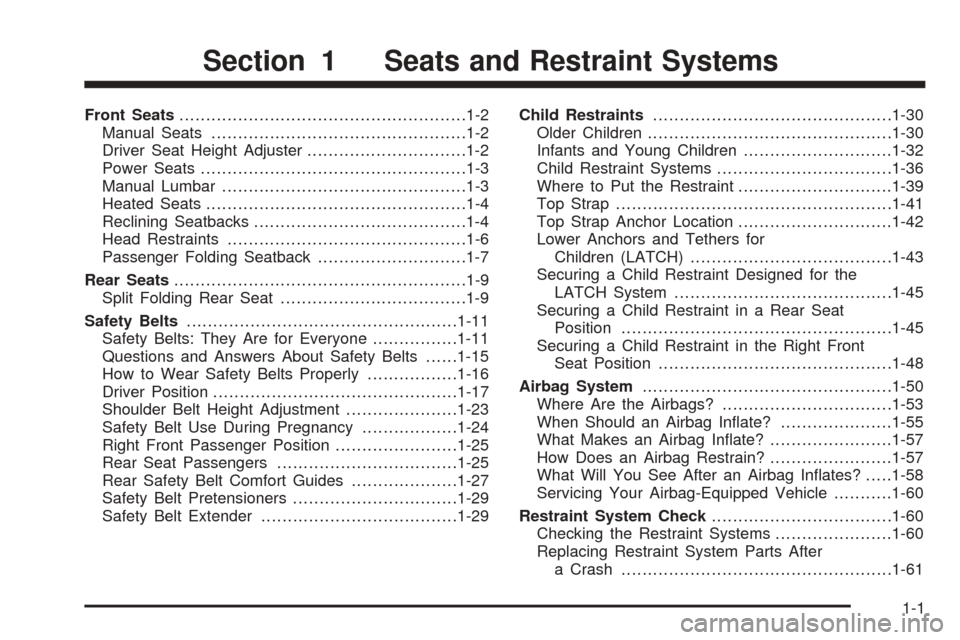
Front Seats......................................................1-2
Manual Seats................................................1-2
Driver Seat Height Adjuster..............................1-2
Power Seats..................................................1-3
Manual Lumbar..............................................1-3
Heated Seats.................................................1-4
Reclining Seatbacks........................................1-4
Head Restraints.............................................1-6
Passenger Folding Seatback............................1-7
Rear Seats.......................................................1-9
Split Folding Rear Seat...................................1-9
Safety Belts...................................................1-11
Safety Belts: They Are for Everyone................1-11
Questions and Answers About Safety Belts......1-15
How to Wear Safety Belts Properly.................1-16
Driver Position..............................................1-17
Shoulder Belt Height Adjustment.....................1-23
Safety Belt Use During Pregnancy..................1-24
Right Front Passenger Position.......................1-25
Rear Seat Passengers..................................1-25
Rear Safety Belt Comfort Guides....................1-27
Safety Belt Pretensioners...............................1-29
Safety Belt Extender.....................................1-29Child Restraints.............................................1-30
Older Children..............................................1-30
Infants and Young Children............................1-32
Child Restraint Systems.................................1-36
Where to Put the Restraint.............................1-39
Top Strap....................................................1-41
Top Strap Anchor Location.............................1-42
Lower Anchors and Tethers for
Children (LATCH)......................................1-43
Securing a Child Restraint Designed for the
LATCH System.........................................1-45
Securing a Child Restraint in a Rear Seat
Position...................................................1-45
Securing a Child Restraint in the Right Front
Seat Position............................................1-48
Airbag System...............................................1-50
Where Are the Airbags?................................1-53
When Should an Airbag In�ate?.....................1-55
What Makes an Airbag In�ate?.......................1-57
How Does an Airbag Restrain?.......................1-57
What Will You See After an Airbag In�ates?.....1-58
Servicing Your Airbag-Equipped Vehicle...........1-60
Restraint System Check..................................1-60
Checking the Restraint Systems......................1-60
Replacing Restraint System Parts After
a Crash...................................................1-61
Section 1 Seats and Restraint Systems
1-1
Page 23 of 364
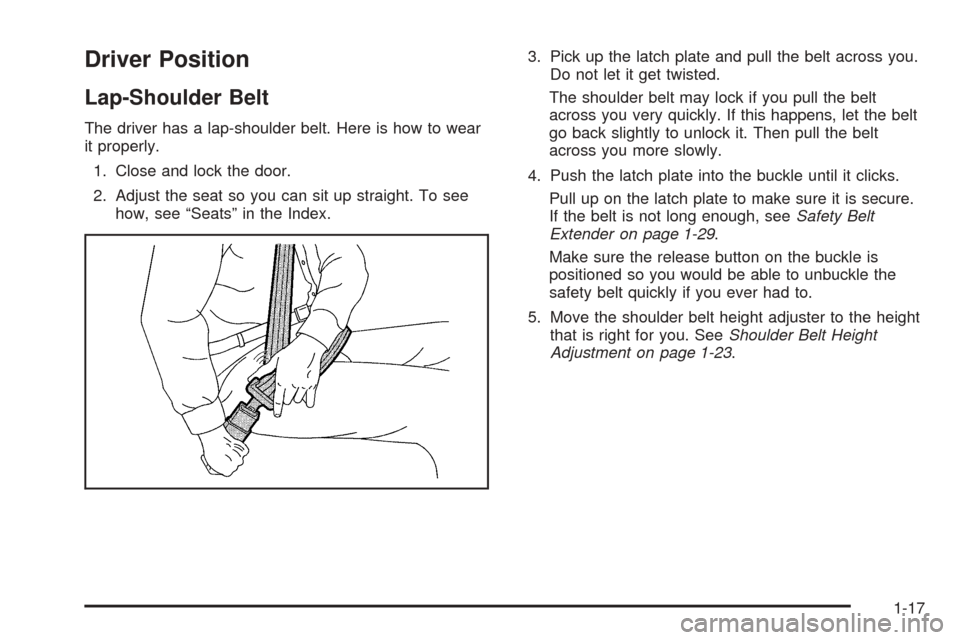
Driver Position
Lap-Shoulder Belt
The driver has a lap-shoulder belt. Here is how to wear
it properly.
1. Close and lock the door.
2. Adjust the seat so you can sit up straight. To see
how, see “Seats” in the Index.3. Pick up the latch plate and pull the belt across you.
Do not let it get twisted.
The shoulder belt may lock if you pull the belt
across you very quickly. If this happens, let the belt
go back slightly to unlock it. Then pull the belt
across you more slowly.
4. Push the latch plate into the buckle until it clicks.
Pull up on the latch plate to make sure it is secure.
If the belt is not long enough, seeSafety Belt
Extender on page 1-29.
Make sure the release button on the buckle is
positioned so you would be able to unbuckle the
safety belt quickly if you ever had to.
5. Move the shoulder belt height adjuster to the height
that is right for you. SeeShoulder Belt Height
Adjustment on page 1-23.
1-17
Page 131 of 364
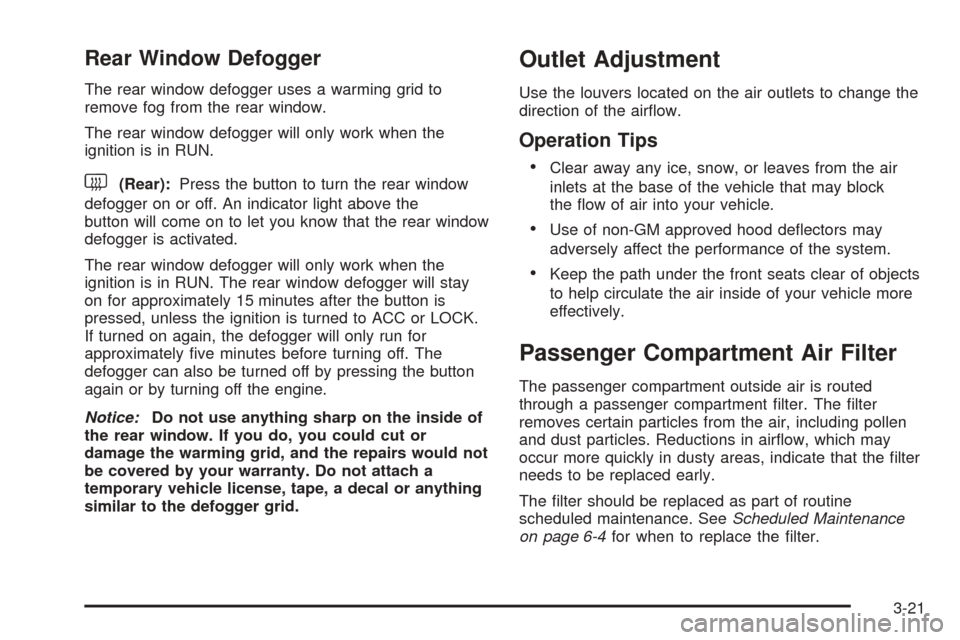
Rear Window Defogger
The rear window defogger uses a warming grid to
remove fog from the rear window.
The rear window defogger will only work when the
ignition is in RUN.
<(Rear):Press the button to turn the rear window
defogger on or off. An indicator light above the
button will come on to let you know that the rear window
defogger is activated.
The rear window defogger will only work when the
ignition is in RUN. The rear window defogger will stay
on for approximately 15 minutes after the button is
pressed, unless the ignition is turned to ACC or LOCK.
If turned on again, the defogger will only run for
approximately �ve minutes before turning off. The
defogger can also be turned off by pressing the button
again or by turning off the engine.
Notice:Do not use anything sharp on the inside of
the rear window. If you do, you could cut or
damage the warming grid, and the repairs would not
be covered by your warranty. Do not attach a
temporary vehicle license, tape, a decal or anything
similar to the defogger grid.
Outlet Adjustment
Use the louvers located on the air outlets to change the
direction of the air�ow.
Operation Tips
Clear away any ice, snow, or leaves from the air
inlets at the base of the vehicle that may block
the �ow of air into your vehicle.
Use of non-GM approved hood de�ectors may
adversely affect the performance of the system.
Keep the path under the front seats clear of objects
to help circulate the air inside of your vehicle more
effectively.
Passenger Compartment Air Filter
The passenger compartment outside air is routed
through a passenger compartment �lter. The �lter
removes certain particles from the air, including pollen
and dust particles. Reductions in air�ow, which may
occur more quickly in dusty areas, indicate that the �lter
needs to be replaced early.
The �lter should be replaced as part of routine
scheduled maintenance. SeeScheduled Maintenance
on page 6-4for when to replace the �lter.
3-21
Page 331 of 364
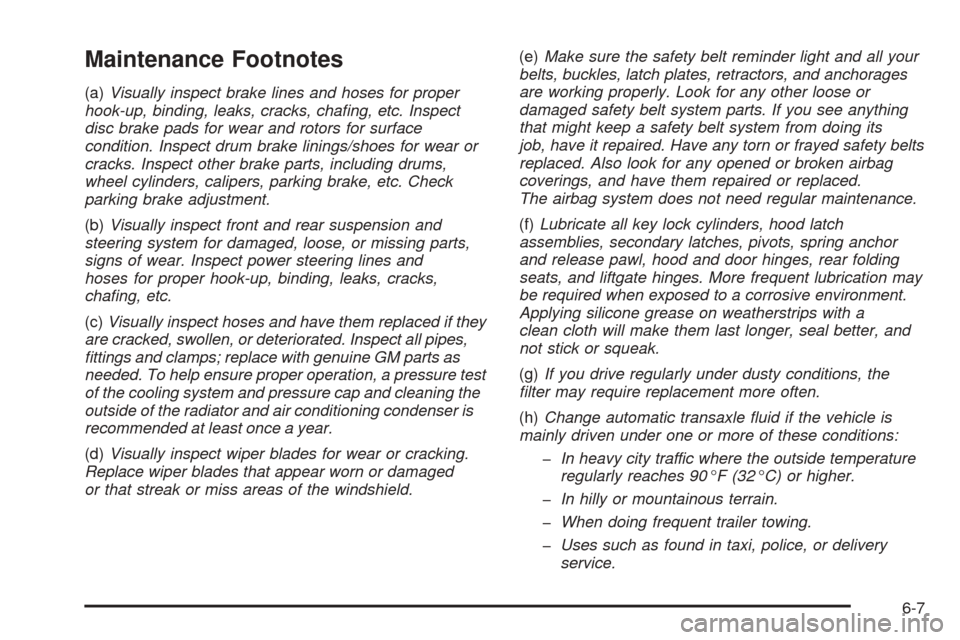
Maintenance Footnotes
(a)Visually inspect brake lines and hoses for proper
hook-up, binding, leaks, cracks, cha�ng, etc. Inspect
disc brake pads for wear and rotors for surface
condition. Inspect drum brake linings/shoes for wear or
cracks. Inspect other brake parts, including drums,
wheel cylinders, calipers, parking brake, etc. Check
parking brake adjustment.
(b)Visually inspect front and rear suspension and
steering system for damaged, loose, or missing parts,
signs of wear. Inspect power steering lines and
hoses for proper hook-up, binding, leaks, cracks,
cha�ng, etc.
(c)Visually inspect hoses and have them replaced if they
are cracked, swollen, or deteriorated. Inspect all pipes,
�ttings and clamps; replace with genuine GM parts as
needed. To help ensure proper operation, a pressure test
of the cooling system and pressure cap and cleaning the
outside of the radiator and air conditioning condenser is
recommended at least once a year.
(d)Visually inspect wiper blades for wear or cracking.
Replace wiper blades that appear worn or damaged
or that streak or miss areas of the windshield.(e)Make sure the safety belt reminder light and all your
belts, buckles, latch plates, retractors, and anchorages
are working properly. Look for any other loose or
damaged safety belt system parts. If you see anything
that might keep a safety belt system from doing its
job, have it repaired. Have any torn or frayed safety belts
replaced. Also look for any opened or broken airbag
coverings, and have them repaired or replaced.
The airbag system does not need regular maintenance.
(f)Lubricate all key lock cylinders, hood latch
assemblies, secondary latches, pivots, spring anchor
and release pawl, hood and door hinges, rear folding
seats, and liftgate hinges. More frequent lubrication may
be required when exposed to a corrosive environment.
Applying silicone grease on weatherstrips with a
clean cloth will make them last longer, seal better, and
not stick or squeak.
(g)If you drive regularly under dusty conditions, the
�lter may require replacement more often.
(h)Change automatic transaxle �uid if the vehicle is
mainly driven under one or more of these conditions:
�In heavy city traffic where the outside temperature
regularly reaches 90°F (32°C) or higher.
�In hilly or mountainous terrain.
�When doing frequent trailer towing.
�Uses such as found in taxi, police, or delivery
service.
6-7
Page 360 of 364
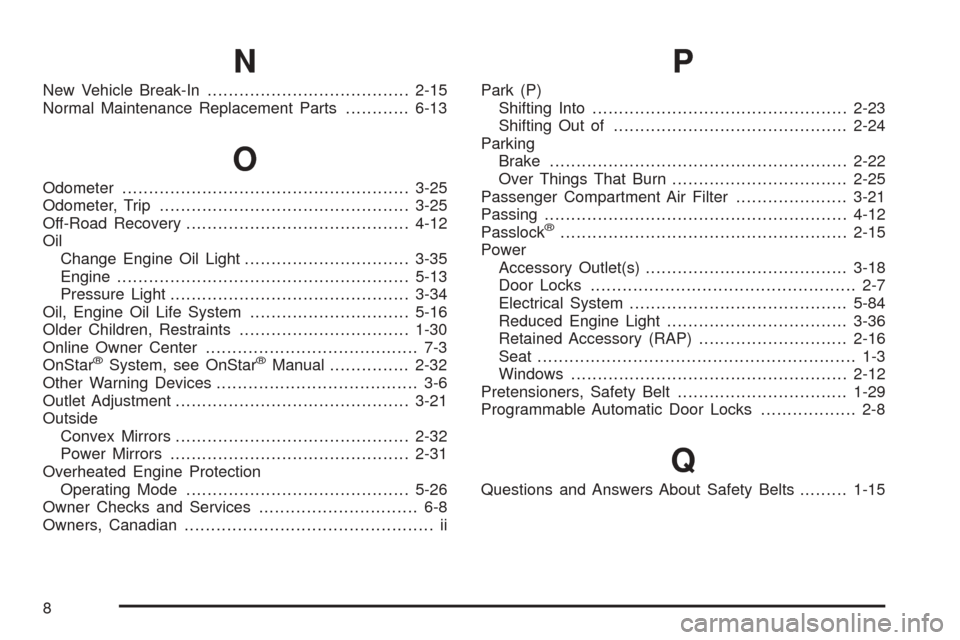
N
New Vehicle Break-In......................................2-15
Normal Maintenance Replacement Parts............6-13
O
Odometer......................................................3-25
Odometer, Trip...............................................3-25
Off-Road Recovery..........................................4-12
Oil
Change Engine Oil Light...............................3-35
Engine.......................................................5-13
Pressure Light.............................................3-34
Oil, Engine Oil Life System..............................5-16
Older Children, Restraints................................1-30
Online Owner Center........................................ 7-3
OnStar
®System, see OnStar®Manual...............2-32
Other Warning Devices...................................... 3-6
Outlet Adjustment............................................3-21
Outside
Convex Mirrors............................................2-32
Power Mirrors.............................................2-31
Overheated Engine Protection
Operating Mode..........................................5-26
Owner Checks and Services.............................. 6-8
Owners, Canadian............................................... ii
P
Park (P)
Shifting Into................................................2-23
Shifting Out of............................................2-24
Parking
Brake........................................................2-22
Over Things That Burn.................................2-25
Passenger Compartment Air Filter.....................3-21
Passing.........................................................4-12
Passlock
®......................................................2-15
Power
Accessory Outlet(s)......................................3-18
Door Locks.................................................. 2-7
Electrical System.........................................5-84
Reduced Engine Light..................................3-36
Retained Accessory (RAP)............................2-16
Seat............................................................ 1-3
Windows....................................................2-12
Pretensioners, Safety Belt................................1-29
Programmable Automatic Door Locks.................. 2-8
Q
Questions and Answers About Safety Belts.........1-15
8